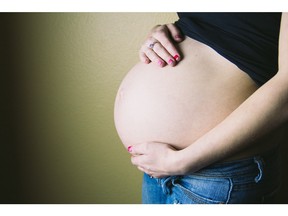N.B. teens give birth at nearly twice national average: report
On average, a woman giving birth in New Brunswick is just below 30, whereas among Canadian women, the average is closer to 32

Article content
New Brunswick still has one of the highest rates of teens giving birth in Canada, despite its overall fertility rate at the national average.
In a new Statistics Canada report on the nation’s fertility, the data show that the proportion of New Brunswick’s teenage girls between the ages of 15 and 19 giving birth is almost twice the national average.
For the most recent year examined, 2022, seven New Brunswick teens gave birth for every 1,000 of them. That compares to 4.4 giving birth per 1,000 teens nation-wide.
Out of 13 provinces and territories, New Brunswick’s rate was the ninth highest. Only Manitoba (9.2), Northwest Territories (12.3), Saskatchewan (14.4) and Nunavut (67.2) were higher. The lowest was in British Columbia, at 2.7.
“When it comes to overall fertility rates for women, New Brunswick has closely followed the national average for much of the last decade,” said Nora Galbraith, co-author of the study and a senior analyst with StatCan’s demography centre.
“Where New Brunswick is a bit more distinct is its age profile of childbearing. It’s a bit younger than the national average in terms of the average age of childbearing and it’s one of only two provinces in the country where the teen fertility rate is higher in comparison to rates of women in their 40s. New Brunswick and Saskatchewan are the two provinces where that’s still the case.”
Younger moms
Galbraith said another distinguishing feature of New Brunswick is the age group with the highest fertility rate – woman aged 25 to 29. In most of the rest of the country, woman have higher rates of fertility in their 30s.
The average age of a woman giving birth in New Brunswick is 29.8 years. That number has increasingly been getting older, much like the national figure. The average age of Canadian mothers at childbirth has been increasing without interruption for nearly five decades, from 26.7 years in 1976 to 31.6 years in 2022.
“There are a number of factors at play and no single cause is driving it,” she said. “But generally speaking, women and couples are waiting to complete their post-secondary education before starting a family, and similarly, when they invest the time and money obtaining that education they want to wait until they secure employment and get their careers going to start a family. That’s a big thing.”
She also said the last 100 years of data show fertility rates ebb and flow with the economic situation. In recent years, the rise of precarious work, more expensive housing and other economic hardships could be weighing on a woman’s decision to have children.
“History shows that in times of economic uncertainty, the birth rate goes down,” the analyst said. “When economic times are good and there’s a positive outlook of the future, it’s the opposite.”
New Brunswick’s total fertility rate – the number of children that would be born to each woman if she were to live to the end of her child-bearing years – is 1.33, the same as the national rate.
This is far below the replacement rate for the population, which would be 2.1 children for each woman during her fertile years.
Demographers for years have stressed the importance of immigration, the main reason Canada continues to have a growing population. The nation grew to 40 million people last June.
Quebec’s big switch
Quebec has seen higher fertility rates in recent years after having the lowest rates for decades. Galbraith said it co-related with more family-friendly policies, such as subsidized daycare and more generous parental leave provisions. It now has the second highest fertility rate (1.49), just behind Saskatchewan’s. In 1987, before those policies were introduced, Quebec recorded its lowest rate of 1.36.
The national, $10-a-day daycare program introduced by the Trudeau Liberal government only recently started and hasn’t caught up with Quebec in most provinces. In New Brunswick, the average cost for people who qualify is $12 a day, but there is still a lack of licensed daycare spaces, particularly for infants.
The availability of kin who can help in caring for a child is a big factor.
Nora Galbraith
Since its creation in 1999, Nunavut has had the highest fertility rate in Canada by a large margin, averaging 2.91 children per woman over the period from 1999 to 2022.
The majority (84 per cent) of Nunavut’s population is Inuit, whose fertility is particularly high, even within the subpopulation of persons who are Indigenous, the report said.
The Northwest Territories has also consistently recorded a higher-than-average fertility rate. Like Nunavut, this higher fertility is likely owing in part to the fact that a significant part of the territory’s population is Indigenous, almost half.
Lower income levels have not dissuaded most Indigenous people from having more children.
“Different cultural norms and values play a factor, including inter-generational patterns that are passed down,” Galbraith said. “The availability of kin who can help in caring for a child is a big factor as well in tightknit, rural societies. In Canada as a whole, as we become more mobile as a society, the likelihood that a young adult lives in the same community as their parents or siblings is decreasing.”












Postmedia is committed to maintaining a lively but civil forum for discussion. Please keep comments relevant and respectful. Comments may take up to an hour to appear on the site. You will receive an email if there is a reply to your comment, an update to a thread you follow or if a user you follow comments. Visit our Community Guidelines for more information.